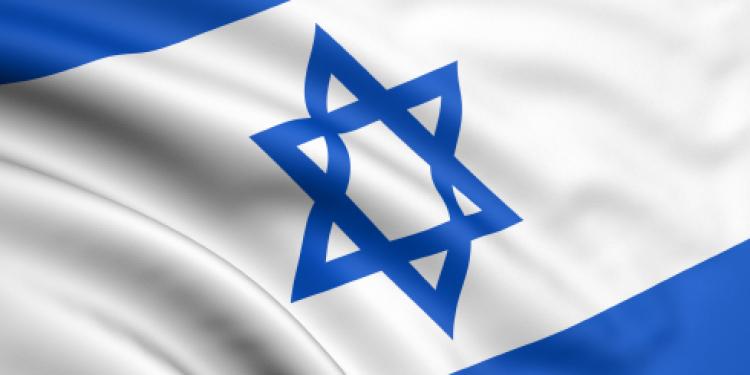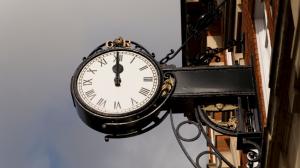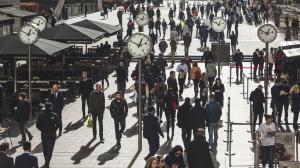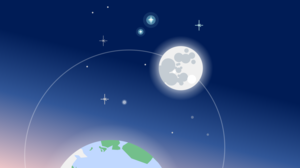
Best Comet of 2025?
C/2024 G3 (ATLAS) has already become very faintly visible to the naked eye for observers in the Southern Hemisphere.
David Ben-Gurion, who was the first prime minister of Israel, publicly read the Declaration of Independence of Israel on May 14, 1948. According to the Jewish calendar, this was the fifth day of Iyar, the eighth month of the civil year, in the year 5708. The anniversary of this date on the Jewish calendar is known as Yom Ha'atzmaut and usually falls in April or May of the Gregorian Calendar.

In the United States and other parts of the world, many Jewish communities observe Yom Ha'atzmaut, which marks the anniversary of Israel's declaration of independence.
©iStockphoto.com/Alexander Hübert
Independence Day is a holiday in Israel and, like many Jewish observances, this "day" starts the evening beforehand. On this evening, the speaker of the Israeli Parliament, or Knesset, holds a speech and there is a dramatic televised presentation. Groups of soldiers carry Israeli flags and form shapes that represent symbols of Judaism, including a seven-branched candelabrum, known as a Menorah, and a regular hexagram, known as the Star of David. In addition, 12 beacons are lit by people who made a special contribution to Israeli society in a particular field. Each of the beacons represents one of the 12 tribes of Israel.
Many people hold parties or sing and dance in the streets to celebrate and fireworks are set off. Young people often hit passers-by on the head with plastic hammers or spray them with shaving foam or silly string. It is also common to display the Israeli flag prominently on homes and cars. Many religious people may read the Torah or say the Hallel, which are six Psalms, or blow the shofar, an instrument made from a ram's horn.
Yom Ha'atzmaut is also celebrated by Jewish people who live outside of Israel. In the United States, large festivals are organized by a number of Jewish communities, for instance in Los Angeles. Other communities organize special synagogue services, dance events, barbecues or picnics. These events may be held on a Sunday close to Israel's Independence Day to enable families to attend.
Israel's Independence Day is not celebrated by everyone. Some Jewish groups feel that the creation of the state of Israel was undesirable or even a sin. They may display a black flag and wear mourning clothes on Yom Ha'atzmaut. In addition, many Arabs feel that the day, which they call al-Nakba, the disaster, represents a loss of national identity that they suffered when the state of Israel was created.
Independence Day is a public holiday in Israel. It is not a public holiday in other countries, including Australia, Canada, the United Kingdom or the United States. However, Jewish organizations may be closed or offer a limited service to allow celebrations to be held. There may be some local disruption to traffic around large scale public events.
The idea of a modern state of Israel dates back to the ideas of Theodor Herzl, a Jewish man born on May 2, 1860, in Pest, now part of Budapest, Hungary. He campaigned for a Jewish state in the Middle East and was instrumental in setting up the Zionist Organization and organizing the First Zionist Congress held in Basel, Switzerland, in August 1897. Herzl died on July 3, 1904.
Following the horrendous atrocities committed against Jewish people and culture in Europe in the run up to and during World War II, there were further calls for a Jewish state to be created. On May 14, 1948, David Ben Gurion, the first prime minister of Israel publicly read the Declaration of Independence of Israel. This event is commemorated each year on Israel's Independence Day, also known as Yom Ha'atzmaut. The day before Yom Ha'atzmaut is Yom Hazikaron. This is a solemn occasion and a day of remembrance and is officially known as "Israel's Day of Remembrance for Fallen Soldiers and Victims of Terrorism".
According to the Jewish calendar, the fifth day of the month of Iyar cannot fall on a Sunday. If this date falls on a Friday or Saturday, Yom Ha'atzmaut is observed on the third or fourth day of the month. If the date falls on a Monday, it is observed on the sixth day of Iyar. This is so that the festivities do not fall just before, on, or just after the Sabbath.
The most prominent symbol of Israel's Independence Day is the flag of Israel. This is a white rectangle in the ratio 11:8 with two horizontal blue stripes, one at the top and one at the bottom. A regular hexagram, known as the Star of David, or Megan David, is depicted in blue between the stripes. The design represents a Jewish prayer shawl, known as a tallit, and was introduced in 1897 as a symbol of the Zionist Organization at the First Zionist Congress.
At the time of the Israelites, Jewish people colored a single thread or the fringes of their prayer shawls with the dye tekhelet, which was obtained from a certain type of shellfish and gave a dark blue color. However, the knowledge on how to collect and process this dye was lost. Over time, it became common for Jewish people to weave blue or purple stripes into the edges of their prayer shawls. The use of a hexagram to symbolize Jewish people and Judaism seems to have originated in medieval times in Prague, now in the Czech Republic.
In the Jewish diaspora—Jewish communities outside of Israel—an extra day is usually added to religious observances, with the exception of Yom Kippur, which lasts only one day worldwide, and Rosh Hashana, which is celebrated over two days in both Israel and the diaspora.
This custom has its roots in ancient times when the beginning of the months in the Jewish calendar still relied on the sighting of the crescent Moon following a New Moon.
The beginning of a new month was determined by the Sanhedrin, the supreme court of ancient Israel in Jerusalem. Once the date was published, messengers were dispatched to spread the news among Jews living abroad. Since this process took some time, it was decreed that Jews outside of ancient Israel were to observe every holiday for 2 days to make sure that the rules and customs applicable to each holiday were observed on the proper date. This rule is still observed today.

C/2024 G3 (ATLAS) has already become very faintly visible to the naked eye for observers in the Southern Hemisphere.

How does the 12-hour clock system work? Is midnight 12 am or 12 pm?

Why do many countries set the clocks back and forth an hour twice a year?

Why are there 12 months? How long are they, and what do the month names mean?